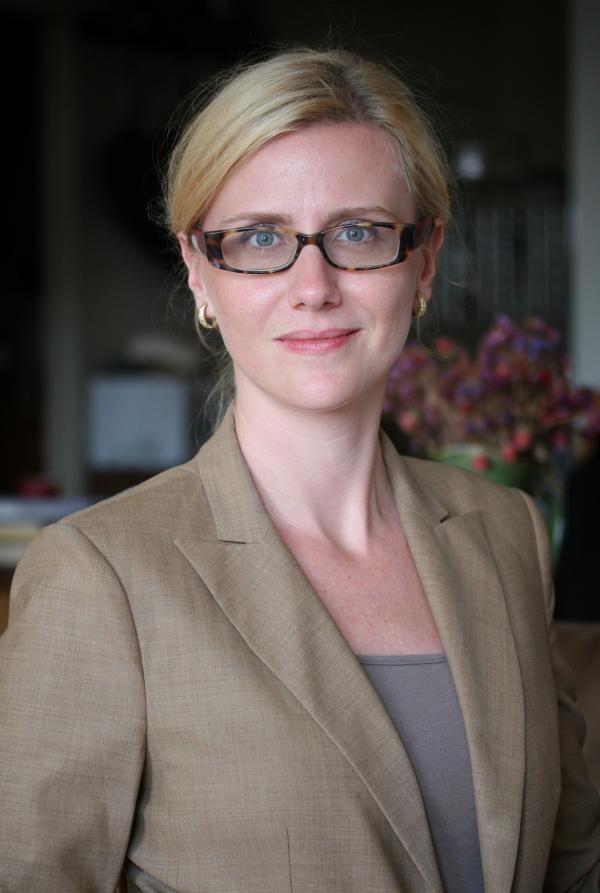
Dr. Emily Greble, assistant professor of history, The City College of New York
Book By Professor Emily Greble Shows How Multiethnic City Tried to Maintain Normalcy Under Rule by Nazis, Croat Nationalists
Sarajevo, the capital of Bosnia and Herzegovina, was subjected to a brutal four-year siege in the 1990s at the hands of Bosnian Serbs seeking to control the new country's political future. It wasn’t the first time the city felt the brunt of war. A new book by Dr. Emily Greble, assistant professor of history at The City College of New York, explores how 50 years earlier its multiethnic communities tried to cope with occupation during World War II.
In “Sarajevo, 1941 – 1945: Muslims, Christians and Jews in Hitler’s Europe” (Cornell University Press 2011), Professor Greble tells what happened when a city with four strong religious communities – Roman Catholic, Eastern Orthodox, Muslim and Jewish – was confronted with a secular, fascist ideology. “Like much of the post-Ottoman world, Sarajevo was a community organized along religious lines. The four religious communities were at the foundation of civil society,” said Professor Greble, a former fellow at the U.S. Holocaust Memorial Museum.
In April 1941, the German army entered Sarajevo. But, rather than being governed as a protectorate of the Third Reich, Sarajevo became part of the new Independent State of Croatia, a Nazi puppet state ruled by the Ustasha, an ultranationalist Croat movement that not only was brutal, but also inept at governing.
Intent on ethnic cleansing, the Ustasha regime first moved against the Jews. Between September and December 1941, 10,000 Jews were deported from Sarajevo. Most were later murdered. While Muslim and Catholic clerics converted several thousand Sarajevo Jews in an effort to save them, the Ustasha regime did not recognize the conversions since it thought of Jews as a race rather than a religion.
Sarajevans had better success at protecting the Orthodox Serb and Muslim Roma communities in their midst. Public officials refused to remove Serbs from civil service posts considered vital to the city’s functioning. They also created a commission that declared Muslim Roma to be Aryan, one of the races protected under Ustasha ideology.
“In Sarajevo, keeping the city running took precedent of the Ustasha agenda,” said Professor Greble, a specialist in Eastern European history. There were lengthy debates, for example, over the disposition of property expropriated from Jews. City leaders focused on maintaining a semblance of normalcy in daily life, keeping community institutions functioning and trying to operate under the rule of law amid wartime chaos.
Relatively few Sarajevans participated in the insurgency movements that sprung up to resist the Nazis. The Communist partisan movement, led by Joseph Broz “Tito,” and the Serb nationalist Chetnik movement held little appeal to a society that was predominantly religious and Bosnian.
Over the course of the occupation, factions within the religious communities attempted to forge alliances with different occupying forces as a way to curry favor for their groups. For example, Sarajevo Muslims formed a Waffen SS unit, but later moved away from the Nazis when the German reneged on a promise to allow an Islamist state to be established in Bosnia, Professor Greble noted.
Roman Catholic leaders sought to align themselves with the Ustasha regime, but the relationship broke down in an ideological debate over baptism. Nazi rhetoric stressed the role of the church in home life, but Nazi ideology had no respect for religious culture or religion as an institution.
Toward the end of the war, the city suffered greatly as Ustasha leaders, realizing their days were numbered, began carrying out mass executions. It was during this time that the legend of “Valter,” the mythic hero of the Yugoslav film “Valter Defends Sarajevo,” was born. “Valter” was actually Vladmir Peric, a local Communist leader who was killed during the April 1945 uprising.
Professor Greble concludes that the Second World War caused as much damage to Sarajevo’s religious and social infrastructure as it did to its physical infrastructure. While the people sought to rebuild their lives and institutions under the aegis of Tito’s Yugoslavia, less than 50 years later their world would unravel again.
On the Web
Professor Greble's profile
/prospective/humanities/history/faculty/egreblebalic
Publisher's description of "Sarajevo, 1941 - 1945"
http://www.cornellpress.cornell.edu/cup_detail.taf?ti_id=9869
IMDb profile of "Valter Defends Sarajevo"
http://www.imdb.com/title/tt0069452/
MEDIA CONTACT
Ellis Simon
p: 212.650.6460
e:
esimon@ccny.cuny.edu